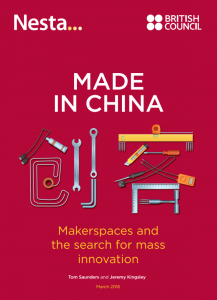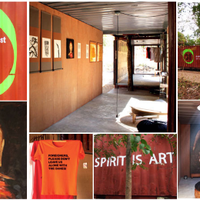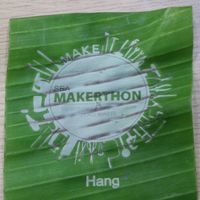Made in China | report surveys makerspaces

Key Findings
- A changing economy means the way that China makes things has to change – from low-cost, labour-intensive manufacturing to innovation and design-led production. For companies, makerspaces have the potential to release the creative energy of their employees.
- A search for innovation-led development is key to the Chinese government’s interest in makerspaces. No longer satisfied with ‘made in China, designed elsewhere’, the government hopes that makerspaces can help foster grassroots innovation and entrepreneurship.
- Makerspaces represent a desire for radical reform of the education system. An innovation-led economy requires more creativity and problem-solving skills. For schools and universities, makerspaces represent a way to bring creativity and hands-on, project-based learning into China’s education system.
- China’s urban middle class are looking to reconnect with craft, just like their western peers. While manufacturing is still a major part of the Chinese economy, millions of young Chinese graduates will never need to work with their hands. For them, makerspaces reflect a desire to be creative and make physical objects.
- China’s makerspaces face a range of challenges:
a. Funding: half the makerspaces surveyed highlighted funding as an issue.
b. Membership: Maintaining membership was a major concern for many spaces.
c. Skills: New members rarely have the skills to use the tools in makerspaces, so makerspaces have to spend time and resources training them.
d. Understanding and advocacy: Few people in China understand maker culture, making it difficult to recruit people interested in making .
In China, making things is a national specialism: whether smartphones or air conditioners, a staggering proportion of the world’s everyday goods are manufactured in the country. But as China’s manufacturing sector matures and the economy grows, companies are beginning to move their factories abroad to take advantage of cheaper wages. As a result, the way that China makes things has to change – from low-cost components, assembly and labour-intensive processes associated with an often pejorative ‘Made in China’ label, to higher-value, innovation-led activities that could see the label develop into a mark of quality.
Against this background, ‘makerspaces’ – open workshops that provide access to a range resources for making physical objects – have spread rapidly across China in the last five years. For many, they signal a new age of grassroots innovation and promise to revolutionise ailing economic, social and educational systems.
Much has been written about the potential of China’s makerspaces, yet they are still little understood outside the country. There are few systematic analyses of China’s maker movement – even basic questions, such as how many makerspaces are there in the country and who uses them, to questions about business models, relationships with businesses and universities, and how and why they differ from their counterparts abroad, remain so far unanswered.
To answer these questions we surveyed almost 100 makerspaces in China, visited makerspaces across the country and interviewed founders and managers. The resulting dataset and report represents the most comprehensive picture of China’s makerspaces to date.
Authors
Tom Saunders and Jeremy Kingsley
Publication is available as free download
Similar content
posted on
03 Oct 2018
posted on
18 Jul 2016
posted on
23 Feb 2011
posted on
11 Sep 2016






